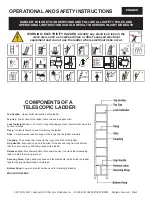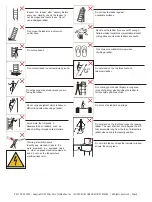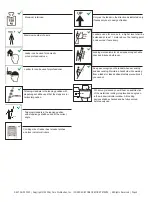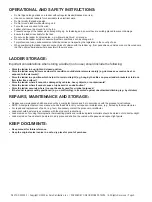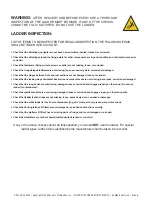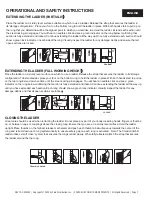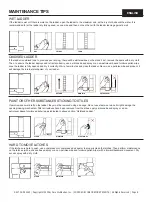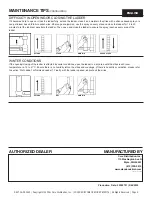
REPAIRS
,
MAINTENANCE
AND STORAGE
:
REV.12-D 202002 | Copyright © 2020 by Core Distribution, Inc. | COVERED BY ONE OR MORE PATENTS | All Rights Reserved | Page
5
KEEP DOCUMENTS
:
•
Keep manual for future reference.
•
Keep the original sales invoice in a safe, dry place for proof of purchase.
LADDER STORAGE
:
Important considerations when storing a ladder (not in use) should include the following:
•
Store the ladder in a upright and closed postion.
•
Store the ladder away from areas where its condition could deteriorate more rapidly (e.g. dampness, excessive heat, or
exposed to the elements)?
•
Store the ladder in a position which helps it to remain straight (e.g. hung by the stiles on proper ladder brackets or laid on
a
flat clutter free surface)?
•
Store the ladder where it cannot be damaged by vehicles, heavy objects, or contaminants?
•
Store the ladder where it cannot cause a trip hazard or an obstruction?
•
Store the ladder securely where it cannot be easily used for criminal purposes?
•
If the ladder is permanently positioned (e.g. on scaffolding), is it secured against unauthorized climbing (e.g. by
children)
•
Do Not Spend long periods on a ladder without regular breaks(tiredness is a risk).
•
Use non-conductive ladders for unavoidable live electrical work.
•
Do Not modify the ladder design.
•
Do Not move a ladder while standing on it.
•
For outdoor use caution to the wind.
•
Ladder shall never be moved from the top.
•
Prevent damage of the ladder when transporting e.g. by fastening and, ensure they are suitably placed to prevent damage.
•
Ensure the ladder is suitable for the task
•
Do not use the ladder if contaminated, e.g. with wet paint, mud, oil or snow.
•
Do not use the ladder outside in adverse weather conditions, such as strong wind .
•
For professional use a risk assessment shall be carried out respecting the legislation in the country of use.
•
When positioning the ladder take into account risk of collision with the ladder e.g. from pedestrians, vehicles or doors. Secure doors
(not fire exits) and windows where possible in the work area.
OPERATIONAL AND SAFETY INSTRUCTIONS
:
•
Repairs and maintenance shall be carried out by a competent person and be in accordance with the producer’s instructions.
•
NOTE: A competent person is someone who has the skills to carry out repairs or maintenance, (e.g. trained by the manufacturer.
•
For repair and replacement of parts, (e.g. feet), if necessary contact the producer or distributor.
•
Ladders should be stored in accordance with the producer's instructions.
•
Ladders made of or using thermoplastic, thermosetting plastic and reinforced plastic materials should be stored out of direct sunlight.
•
Ladders made of wood should be stored in a dry place and shall not be coated with opaque and vapour-tight paints.


